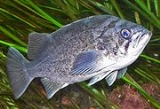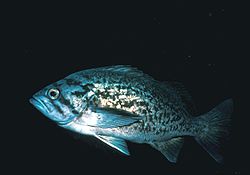
Blue rockfish
Encyclopedia
The blue rockfish, Sebastes mystinus, is a rockfish
of the Pacific
coast found from Alaska
to Baja California
.
Blue rockfish have a relatively smooth and oval appearance compared to other members of Sebastes, with very few head spines. Color is a bluish black to gray, with some darker mottling, including a pair of stripes angling down and back from the eye. The terminal mouths are small for rockfish. Length ranges up to 55 to 60 cm, and weights up to 3.8 kg.
They occur from Sitka Strait in the north to Punta Santo Tomas in Baja, most commonly along Oregon and northern California (records of blue rockfish in the western Gulf of Alaska
and the Bering Sea
probably refer to the related dusky rockfish.) While they have been caught at depths of over 500 m, most live near to the surface, down to 90 m.
 Diet is plankton
Diet is plankton
. Juveniles consume tiny crustacea
such as copepod
s and barnacle
larva
e (in some cases having a significant effect on the population), while adults shift to larger types, such as free-swimming tunicate
s, jellyfish
, gastropods, squid
s, young rockfish, and drifting plant fragments.
Blue rockfish were once an important part of the California fishery; they were the most common rockfish marketed in San Francisco and San Diego during the 19th century, but have since declined in popularity. They continue to be of interest as game fish
, and are among the most common types landed by boat anglers; in fact, there is evidence of overfishing
in Monterey Bay
and southern California.
The species epithet mystinus derives from the Greek for "priest", referring to the overall dark color.
Sebastidae
Sebastidae is a family of marine fish in the order Scorpaeniformes. Their common names include rockfishes, thornyheads and rockcods. Despite the latter name, they are not closely related to the cods in the genus Gadus, nor the rock cod, Lotella rhacina.Not all authorities recognise this family as...
of the Pacific
Pacific Ocean
The Pacific Ocean is the largest of the Earth's oceanic divisions. It extends from the Arctic in the north to the Southern Ocean in the south, bounded by Asia and Australia in the west, and the Americas in the east.At 165.2 million square kilometres in area, this largest division of the World...
coast found from Alaska
Alaska
Alaska is the largest state in the United States by area. It is situated in the northwest extremity of the North American continent, with Canada to the east, the Arctic Ocean to the north, and the Pacific Ocean to the west and south, with Russia further west across the Bering Strait...
to Baja California
Baja California
Baja California officially Estado Libre y Soberano de Baja California is one of the 31 states which, with the Federal District, comprise the 32 Federal Entities of Mexico. It is both the northernmost and westernmost state of Mexico. Before becoming a state in 1953, the area was known as the North...
.
Blue rockfish have a relatively smooth and oval appearance compared to other members of Sebastes, with very few head spines. Color is a bluish black to gray, with some darker mottling, including a pair of stripes angling down and back from the eye. The terminal mouths are small for rockfish. Length ranges up to 55 to 60 cm, and weights up to 3.8 kg.
They occur from Sitka Strait in the north to Punta Santo Tomas in Baja, most commonly along Oregon and northern California (records of blue rockfish in the western Gulf of Alaska
Gulf of Alaska
The Gulf of Alaska is an arm of the Pacific Ocean defined by the curve of the southern coast of Alaska, stretching from the Alaska Peninsula and Kodiak Island in the west to the Alexander Archipelago in the east, where Glacier Bay and the Inside Passage are found.The entire shoreline of the Gulf is...
and the Bering Sea
Bering Sea
The Bering Sea is a marginal sea of the Pacific Ocean. It comprises a deep water basin, which then rises through a narrow slope into the shallower water above the continental shelves....
probably refer to the related dusky rockfish.) While they have been caught at depths of over 500 m, most live near to the surface, down to 90 m.

Plankton
Plankton are any drifting organisms that inhabit the pelagic zone of oceans, seas, or bodies of fresh water. That is, plankton are defined by their ecological niche rather than phylogenetic or taxonomic classification...
. Juveniles consume tiny crustacea
Crustacean
Crustaceans form a very large group of arthropods, usually treated as a subphylum, which includes such familiar animals as crabs, lobsters, crayfish, shrimp, krill and barnacles. The 50,000 described species range in size from Stygotantulus stocki at , to the Japanese spider crab with a leg span...
such as copepod
Copepod
Copepods are a group of small crustaceans found in the sea and nearly every freshwater habitat. Some species are planktonic , some are benthic , and some continental species may live in limno-terrestrial habitats and other wet terrestrial places, such as swamps, under leaf fall in wet forests,...
s and barnacle
Barnacle
A barnacle is a type of arthropod belonging to infraclass Cirripedia in the subphylum Crustacea, and is hence related to crabs and lobsters. Barnacles are exclusively marine, and tend to live in shallow and tidal waters, typically in erosive settings. They are sessile suspension feeders, and have...
larva
Larva
A larva is a distinct juvenile form many animals undergo before metamorphosis into adults. Animals with indirect development such as insects, amphibians, or cnidarians typically have a larval phase of their life cycle...
e (in some cases having a significant effect on the population), while adults shift to larger types, such as free-swimming tunicate
Tunicate
Tunicates, also known as urochordates, are members of the subphylum Tunicata, previously known as Urochordata, a group of underwater saclike filter feeders with incurrent and excurrent siphons that is classified within the phylum Chordata. While most tunicates live on the ocean floor, others such...
s, jellyfish
Jellyfish
Jellyfish are free-swimming members of the phylum Cnidaria. Medusa is another word for jellyfish, and refers to any free-swimming jellyfish stages in the phylum Cnidaria...
, gastropods, squid
Squid
Squid are cephalopods of the order Teuthida, which comprises around 300 species. Like all other cephalopods, squid have a distinct head, bilateral symmetry, a mantle, and arms. Squid, like cuttlefish, have eight arms arranged in pairs and two, usually longer, tentacles...
s, young rockfish, and drifting plant fragments.
Blue rockfish were once an important part of the California fishery; they were the most common rockfish marketed in San Francisco and San Diego during the 19th century, but have since declined in popularity. They continue to be of interest as game fish
Game fish
Game fish are fish pursued for sport by recreational anglers. They can be freshwater or marine fish. Game fish can be eaten after being caught, though increasingly anglers practise catch and release to improve fish populations. Some game fish are also targeted commercially, particularly...
, and are among the most common types landed by boat anglers; in fact, there is evidence of overfishing
Overfishing
Overfishing occurs when fishing activities reduce fish stocks below an acceptable level. This can occur in any body of water from a pond to the oceans....
in Monterey Bay
Monterey Bay
Monterey Bay is a bay of the Pacific Ocean, along the central coast of California. The bay is south of San Francisco and San Jose, between the cities of Santa Cruz and Monterey....
and southern California.
The species epithet mystinus derives from the Greek for "priest", referring to the overall dark color.

